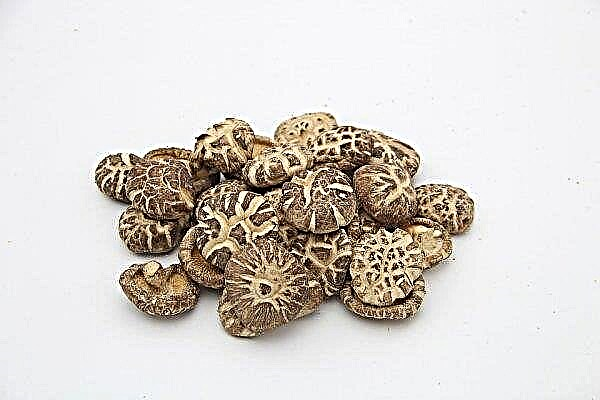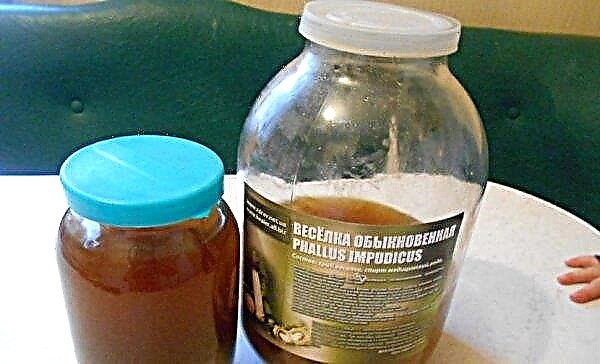Often in freshwater you can meet bream or other fish with strange behavior. Most likely, the reason for this is the tapeworm. What is it and what danger is for a person, read on.
What is a tapeworm
Tapeworm, or tape - a flat tapeworm, a parasite. They lack the digestive system, and they survive at the expense of the blood of their host victim. They live and develop in the intestines. Usually their life cycle implies the presence of different hosts in its different periods. In the body, the intermediate victims live in the tissues and cavities of the body.

What does a worm look like?
Tapeworm is the largest representative of tapeworms. Able to reach several meters in length. In fish, its size rarely exceeds 25 cm, with a width of 2 cm. Its appearance is very primitive, resembles a twisted, uneven and rumpled white ribbon, divided into segments.
These are the parts involved in the reproduction process. There can be a huge number of them. When they reach the amount of 60 pcs. the process of cross-mating begins. Eggs appear in the segments, which after a certain period of time go out into the environment through the hole.
Important! The tapeworm is able to recover from one segment torn off from the common “tape” of the worm. The main thing is that a favorable environment surrounds him.
How to identify infected fish
White fish suffer the most from the parasite. These include bream. The smaller fish and crustaceans that feed the bream are carriers of the worm. Waterfowl are also present in this chain.
After eating parasite-infected prey, the bream itself becomes a victim of the lentec. Once in the abdominal cavity, it begins to grow rapidly and becomes a cause of disorder in the work of body systems. It compresses the swimming bladder and other organs, which is why the behavior of the fish changes dramatically.

You can determine this by the following signs:
- Due to problems with the swimming bladder, the tapeworm cannot go deeper than three meters. Often floats on the surface or near it, with its side or turned over on its back.
- The infected bream has a bloated, elastic belly, and if you press on it, part of the worm may appear from the anus.
- Eyes are bulging, look bulging.
- It is very easy to catch a sick individual (even with bare hands). She practically does not resist when fighting.
- If you gut the solitary catch, then a white ribbon will be present in the belly.
Important! Most often, infected bream can be caught in late spring and summer, sometimes — in early spring, when ice still remained in places in the reservoir.
Danger to humans
Many believe that if you gut the sick fish, then it is no longer dangerous to humans. But they forget that in its tissues are the parasite larvae, which are not visible without an increase. If such a larva (even one) enters the human body, then in a couple of months it will already be an adult worm of enormous size.
Ribbon growth rarely affects a person’s general condition. Only sometimes this process is accompanied by dizziness, nausea, pain in the abdomen, malfunction of the digestive tract, the appearance of irritability, rash.

Often there are such deviations in the functioning of the nervous system:
- indifference to what is happening around, depressed, apathetic state;
- drowsiness, sleep disturbance;
- feeling of anxiety, cramps of limbs;
- partial memory lapses (individual moments are forgotten).
In parallel with this, a number of changes occur in the body that cause diphyllobothriasis, megaloblastic anemia, bowel obstruction.
Did you know? In 2015, a tapeworm with a length of 620 cm was removed from the body of a Chinese man. It reached these sizes for more than two years.
If the parasite enters the children's body, it does even more harm:
- slows down the process of development and growth;
- provokes the development of diseases of the circulatory system;
- provokes the appearance of an allergy to food;
- causes prolonged diarrhea;
- lowers immunity.
Sometimes it happens that a person’s immune system is strong and expels the parasite (it cannot survive in an aggressive environment and leaves it). However, he leaves behind offspring. A new ribbon can grow out of the eggs, if only they survive in an environment unfavorable to them.
 Tape parasites tend to penetrate the blood-brain barrier and disrupt the brain. There have been cases of penetration into other organs (liver, lungs).
Tape parasites tend to penetrate the blood-brain barrier and disrupt the brain. There have been cases of penetration into other organs (liver, lungs).
Is it possible to eat a bream with a tapeworm
If you are not afraid of the likelihood of becoming infected and the possible consequences, then you can eat solitary bream. Previously, you need to properly prepare it. First, the carcass should be cut, and then thoroughly washed under running water.
Tapeworm larvae are very stable, so the meat must be finely chopped to be carefully processed. It should be remembered that eggs can remain on everything that came into contact with the infected bream. For this reason, all dishes, appliances and hands must be thoroughly washed under hot water with laundry soap and chemicals.
Fish Processing Methods
After preparing the carcass, you can proceed to its processing.
Its possible types are:
- freezing - a temperature of –20 ° C for 3 days can kill eggs;
- pickling - the ratio between the amount of salt and the weight of the fish should be at least 12%, salt should be a week;
- frying, cooking - Cook for 30 minutes or fry for 15 minutes;
- roasting - on an open fire;
- smoking - hot method for at least two hours.
 You need to be prepared for the fact that the dish will differ in taste from a similar one prepared from normal meat. This is due to the fact that the parasite does not allow the bream to develop normally, respectively, its tissues will be changed, and therefore others will taste.
You need to be prepared for the fact that the dish will differ in taste from a similar one prepared from normal meat. This is due to the fact that the parasite does not allow the bream to develop normally, respectively, its tissues will be changed, and therefore others will taste.
Disease prevention
Salt water is a less favorable environment for the life of the lentets, because of this it is less common in marine fish. Accordingly, in order to avoid infection, it is better to abandon the use of river fish. If this is not possible, then you should exclude from the diet jerky, especially our own production, smoked (cold processed), slightly salted, raw fish.
If you ate a bream and are not sure of its quality, then it is better to go to a pharmacy for antiparasitic drugs: Fenisal, Pirantel, Piperazin. These drugs act destructively on the body of the tape, not allowing its organs to develop normally.
Did you know? Some types of tapeworms can destroy 95% if they don’t have what to eat.
Tapeworm is a dangerous parasite that can harm any living organism. It is better to avoid contact with him, and if it already happened that he entered your body, take measures to destroy it.












